
Samphire is a name given to a number of succulent salt-tolerant plants (halophytes) that tend to be associated with water bodies.

Acacia coriacea, commonly known as river jam, wirewood, desert oak, wiry wattle or dogwood, is a tree in the family Mimosoideae of family Fabaceae. Indigenous Australians know the plant as Gunandru.
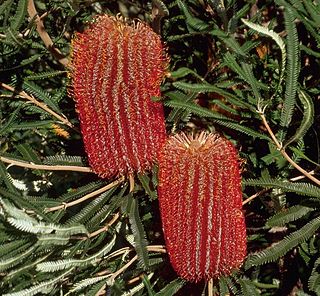
Banksia brownii, commonly known as feather-leaved banksia or Brown's banksia, is a species of shrub that grows in southwest Western Australia. An attractive plant with fine feathery leaves and large red-brown flower spikes, it usually grows as an upright bush around two metres (7 ft) high, but can also occur as a small tree or a low spreading shrub. First collected in 1829 and published the following year, it is placed in Banksiasubgenus Banksia, section Oncostylis, series Spicigerae. There are two genetically distinct forms.

Banksia littoralis, commonly known as the swamp banksia, swamp oak, river banksia or seaside banksia and the western swamp banksia, is a species of tree that is endemic to the south-west of Western Australia. The Noongar peoples know the plant as pungura, boongura or gwangia. It has rough, crumbly bark, linear, more or less serrated leaves arranged in whorls, yellow flowers and up to two hundred follicles in each head.

Banksia tricuspis, commonly known as Lesueur banksia or pine banksia, is a plant in the family Proteaceae and is endemic to a small area in the south-west of Western Australia. It is a stunted tree or shrub with narrow leaves and cylindrical spikes of golden-coloured flowers and it occurs in a geographic range of just 15 square kilometres near Jurien.
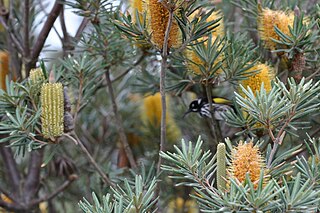
Banksia verticillata, commonly known as granite banksia or Albany banksia, is a species of shrub or (rarely) tree of the genus Banksia in the family Proteaceae. It is native to the southwest of Western Australia and can reach up to 3 m (10 ft) in height. It can grow taller to 5 m (16 ft) in sheltered areas, and much smaller in more exposed areas. This species has elliptic green leaves and large, bright golden yellow inflorescences or flower spikes, appearing in summer and autumn. The New Holland honeyeater is the most prominent pollinator, although several other species of honeyeater, as well as bees, visit the flower spikes.

Grevillea striata, also known as beefwood, is a tree or shrub native to all Australian states, with the exception of Victoria and Tasmania. Alternative common names for this species include western beefwood, beef oak, beef silky oak and silvery honeysuckle.
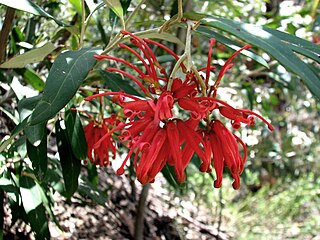
Grevillea victoriae, also known as royal grevillea or mountain grevillea, is a shrub which is endemic to south-eastern New South Wales and mountainous parts of Victoria in Australia.
This is a list of the terrestrial flora of the Houtman Abrolhos. Only vascular plants are listed — there have been some collections of mosses, liverworts and lichens from the Houtman Abrolhos, but no information has been published on these non-vascular groups.
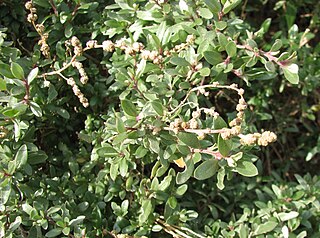
Atriplex paludosa, commonly known as marsh saltbush, is a species of saltbush endemic to Australia.
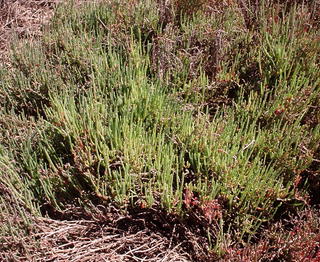
Tecticornia is a genus of succulent, salt tolerant plants largely endemic to Australia. Taxa in the genus are commonly referred to as samphires. In 2007, the genus Halosarcia, along with three other Australian genera was incorporated into the genus.
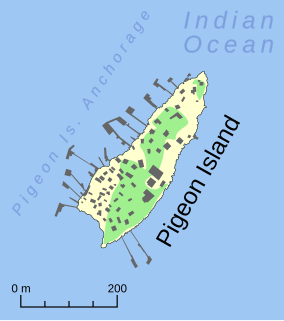
Pigeon Island is a small island located need the middle of the Wallabi Group of the Houtman Abrolhos, an archipelago off the coast of Western Australia. It is almost entirely given over to western rock lobster fishers' camps, and as a result is far more disturbed than most other islands in the archipelago. A nearby island also seasonally populated by fishers is named Little Pigeon Island, hence Pigeon Island is sometimes referred to as "Big Pigeon Island".

Tecticornia halocnemoides, commonly known as shrubby samphire or grey glasswort, is a species of succulent, salt tolerant plant endemic to Australia. It grows as a spreading or erect shrub up to fifty centimetres high. It was first published as Arthrocnemum halocnemoides in 1845, but transferred into Halosarcia in 1980, and into Tecticornia in 2007.

Frankenia pauciflora, the common sea-heath or southern sea-heath, is an evergreen shrub native to southern Australia. It is part of the Frankenia genus of the Frankeniaceae family.
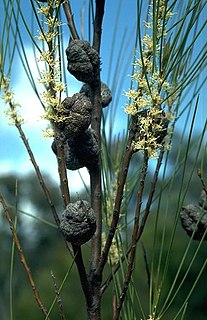
Hakea dohertyi, commonly known as the Kowmung hakea, is a shrub endemic to a restricted locale in the Great Dividing Range in central New South Wales in Australia.

Grevillea ramosissima, commonly known as fan grevillea, is a shrub species of the family Proteaceae. It is native to south-eastern Australia.

Ehretia saligna, commonly known as peach bush, native willow and peachwood is a species of shrubs or small trees, endemic to Northern Australia. The natural range extends from the Gascoyne, across the Northern Territory throughout northern Queensland and coastal; regions of Southern Queensland and New South Wales.
Grevillea kennedyana is a sprawling shrub of the genus Grevillea. It is only found in a small part of Australia, with a natural range less than 100 km. It is considered a vulnerable under federal and state legislation. G. kennedyana is also known as the flame spider-flower.

Acacia cana, or commonly named as boree or the cabbage-tree wattle or broad-leaved nealie, is part of the family Fabaceae and sub-family Mimosoideae. It is a dense shrub- tree that can grow to 6 metres (20 ft) high and is a perennial plant meaning it has long life span and doesn’t necessary produce a high amount of seed. The cabbage-tree wattle heavily flowers from August till October and relies on animals and insects for pollination and dispersal of seeds. This least concern acacia species is found in the western plains of New South Wales and Central Queensland the habitats of these areas are found to be sandy soils and gibber plains.
Kelly Anne Shepherd is an Australian botanist, who has published some 91 names.

















